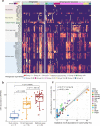Phylogenetically and catabolically diverse diazotrophs reside in deep-sea cold seep sediments
- PMID: 35985998
- PMCID: PMC9391474
- DOI: 10.1038/s41467-022-32503-w
Phylogenetically and catabolically diverse diazotrophs reside in deep-sea cold seep sediments
Abstract
Microbially mediated nitrogen cycling in carbon-dominated cold seep environments remains poorly understood. So far anaerobic methanotrophic archaea (ANME-2) and their sulfate-reducing bacterial partners (SEEP-SRB1 clade) have been identified as diazotrophs in deep sea cold seep sediments. However, it is unclear whether other microbial groups can perform nitrogen fixation in such ecosystems. To fill this gap, we analyzed 61 metagenomes, 1428 metagenome-assembled genomes, and six metatranscriptomes derived from 11 globally distributed cold seeps. These sediments contain phylogenetically diverse nitrogenase genes corresponding to an expanded diversity of diazotrophic lineages. Diverse catabolic pathways were predicted to provide ATP for nitrogen fixation, suggesting diazotrophy in cold seeps is not necessarily associated with sulfate-dependent anaerobic oxidation of methane. Nitrogen fixation genes among various diazotrophic groups in cold seeps were inferred to be genetically mobile and subject to purifying selection. Our findings extend the capacity for diazotrophy to five candidate phyla (Altarchaeia, Omnitrophota, FCPU426, Caldatribacteriota and UBA6262), and suggest that cold seep diazotrophs might contribute substantially to the global nitrogen balance.
© 2022. The Author(s).
Conflict of interest statement
The authors declare no competing interest.
Figures







Similar articles
-
Community Structure and Microbial Associations in Sediment-Free Methanotrophic Enrichment Cultures from a Marine Methane Seep.Appl Environ Microbiol. 2022 Jun 14;88(11):e0210921. doi: 10.1128/aem.02109-21. Epub 2022 May 23. Appl Environ Microbiol. 2022. PMID: 35604226 Free PMC article.
-
Cold Seeps on the Passive Northern U.S. Atlantic Margin Host Globally Representative Members of the Seep Microbiome with Locally Dominant Strains of Archaea.Appl Environ Microbiol. 2022 Jun 14;88(11):e0046822. doi: 10.1128/aem.00468-22. Epub 2022 May 24. Appl Environ Microbiol. 2022. PMID: 35607968 Free PMC article.
-
Methane-metabolizing microbial communities in sediments of the Haima cold seep area, northwest slope of the South China Sea.FEMS Microbiol Ecol. 2017 Sep 1;93(9). doi: 10.1093/femsec/fix101. FEMS Microbiol Ecol. 2017. PMID: 28934399
-
Unexpected genetic and microbial diversity for arsenic cycling in deep sea cold seep sediments.NPJ Biofilms Microbiomes. 2023 Mar 29;9(1):13. doi: 10.1038/s41522-023-00382-8. NPJ Biofilms Microbiomes. 2023. PMID: 36991068 Free PMC article. Review.
-
Physiology and Distribution of Archaeal Methanotrophs That Couple Anaerobic Oxidation of Methane with Sulfate Reduction.Microbiol Mol Biol Rev. 2019 Jul 31;83(3):e00074-18. doi: 10.1128/MMBR.00074-18. Print 2019 Aug 21. Microbiol Mol Biol Rev. 2019. PMID: 31366606 Free PMC article. Review.
Cited by
-
Disentangling the Functional Role of Fungi in Cold Seep Sediment.Microbiol Spectr. 2023 Mar 13;11(2):e0197822. doi: 10.1128/spectrum.01978-22. Online ahead of print. Microbiol Spectr. 2023. PMID: 36912690 Free PMC article.
-
A vast repertoire of secondary metabolites potentially influences community dynamics and biogeochemical processes in cold seeps.Sci Adv. 2024 Apr 26;10(17):eadl2281. doi: 10.1126/sciadv.adl2281. Epub 2024 Apr 26. Sci Adv. 2024. PMID: 38669328 Free PMC article.
-
Cultivation and metabolic versatility of novel and ubiquitous chemolithoautotrophic Campylobacteria from mangrove sediments.Microbiol Spectr. 2025 Sep 2;13(9):e0036725. doi: 10.1128/spectrum.00367-25. Epub 2025 Jul 23. Microbiol Spectr. 2025. PMID: 40698828 Free PMC article.
-
Chemosynthetic alphaproteobacterial diazotrophs reside in deep-sea cold-seep bottom waters.mSystems. 2024 Sep 17;9(9):e0017624. doi: 10.1128/msystems.00176-24. Epub 2024 Aug 6. mSystems. 2024. PMID: 39105582 Free PMC article.
-
Comparative metagenomics highlights the habitat-related diversity in taxonomic composition and metabolic potential of deep-sea sediment microbiota.Heliyon. 2024 Oct 9;10(22):e39055. doi: 10.1016/j.heliyon.2024.e39055. eCollection 2024 Nov 30. Heliyon. 2024. PMID: 39634420 Free PMC article.
References
-
- Joye SB. The Geology and Biogeochemistry of Hydrocarbon Seeps. Annu Rev. Earth Planet Sci. 2020;48:205–231. doi: 10.1146/annurev-earth-063016-020052. - DOI
-
- Clark JF, Washburn L, Hornafius JS, Luyendyk BP. Dissolved hydrocarbon flux from natural marine seeps to the southern California Bight. J. Geophys Res-Oceans. 2000;105:11509–11522. doi: 10.1029/2000JC000259. - DOI
Publication types
MeSH terms
Substances
LinkOut - more resources
Full Text Sources
Miscellaneous

